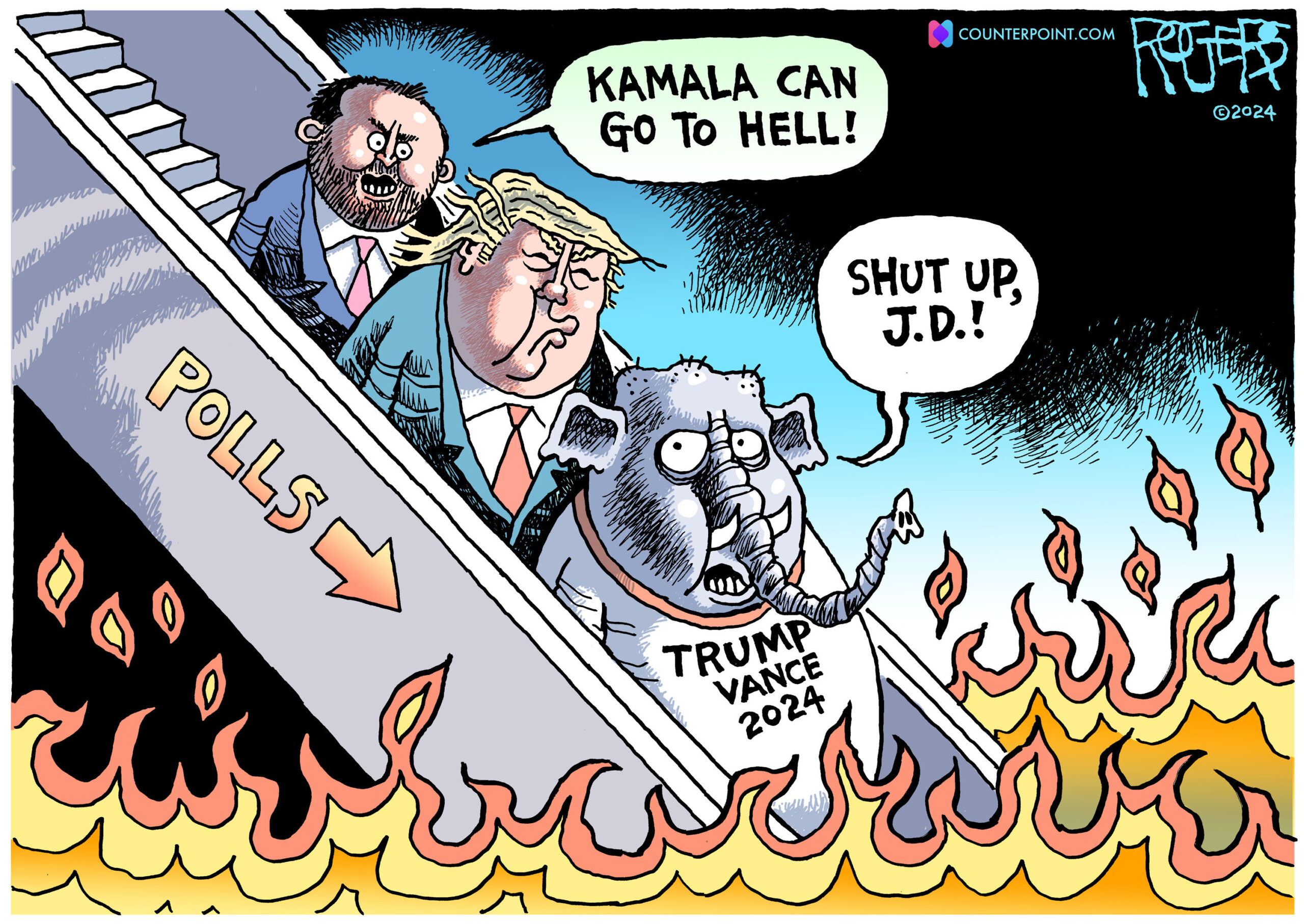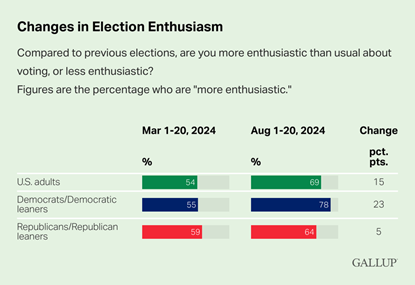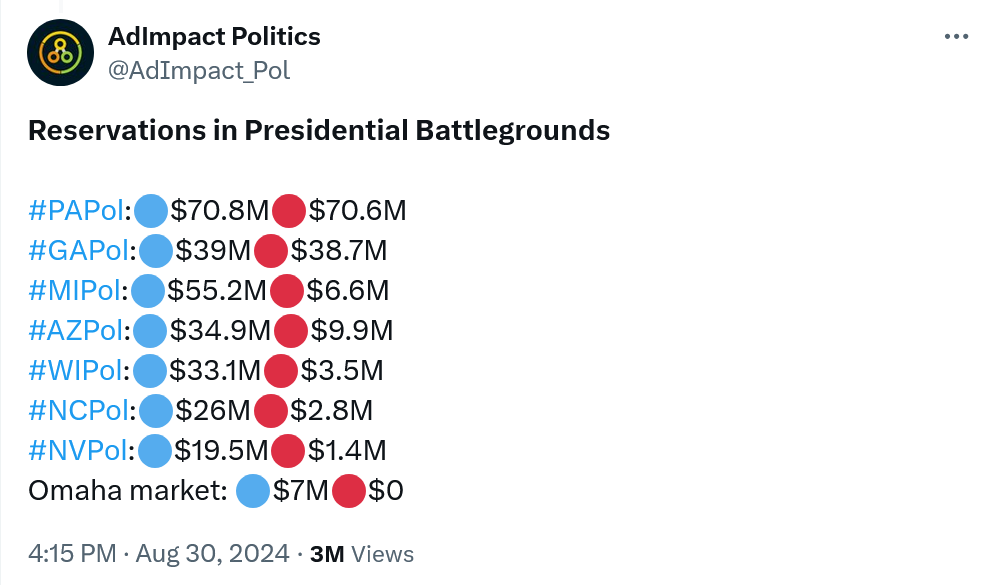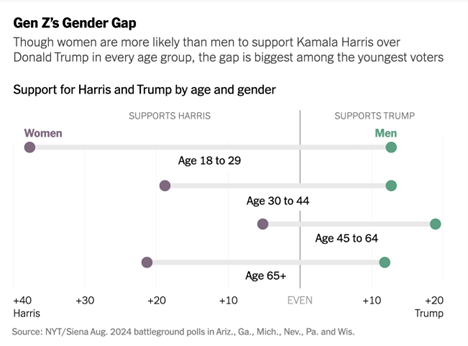(Welcome to another of Wrongo’s occasional thoughts about the election. He wants to thank you for your concern as he travels through Chemo land.)
The Daily Escape:

Polling isn’t all that we want it to be or think it can be. But the recent trends support growing confidence that Harris is succeeding Biden. For example, a recent USA TODAY/Suffolk University poll (highly rated in the 538’s curation of polls), shows an eight or nine-point swing in favor of Harris, relative to the survey it took at the end of June, after the disastrous Biden debate:
“Democrat Kamala Harris has surged ahead of Republican Donald Trump, 48%-43%, a new USA TODAY/Suffolk University Poll found….The findings reflect an eight-point turnaround in the presidential race from late June, when Trump had led President Joe Biden in the survey by nearly four points.
The vice president’s small lead was fueled by big shifts among some key demographic groups traditionally crucial for Democrats, including Hispanic and Black voters and young people. Among those with annual incomes of less than $20,000, in the biggest change, a three-point Trump edge over Biden in June has become a 23-point Harris advantage over Trump in August.”
The poll of 1,000 likely voters, taken by landline and cell phone Sunday through Wednesday, has a margin of error of plus or minus 3.1 percentage points. With the election approaching, the survey is now measuring likely voters; previous polls were of registered voters.”
It’s a tiny sample that needs more supportive data. Sunday’s ABC News/Ipsos poll showed Harris leading 52%-46% among likely voters, a six-point lead. But the race is much closer in swing states. This means that the whole ball game is going to come down to turnout and enthusiasm. There are very few real swing voters left in America today, because the kind of person who has trouble choosing between the Democrats and the Republicans is somebody who probably couldn’t decide which country is directly north of the USA.
Two factors in turnout are the changes in voter enthusiasm and spending by the Parties. Here’s Gallup on changes in enthusiasm:

We should remember that enthusiasm for Harris is driven by hope, while enthusiasm for Trump is driven by fear. One is easier to stoke than the other.
Second, Ad Impact Politics, a firm that tracks political spending, says that between Labor Day and Election Day, 96 different markets are set to see at least $1M in political ad spending on TV. Twenty- eight markets are set to see over $20M, and Philadelphia, Phoenix, and Las Vegas are all set to see over $110M! Here’s how that breaks down by TV time slot reservations:

The Trump campaign is only going to be competitive in Pennsylvania and Georgia. The other swing states are apparently being left to their own devices. Their strategy seems to be if they can hold all their 2020 states they can put all their money on picking up those two states which will bring them to exactly 270. If they lose either one (or NC) that’s the ballgame.
A subtext is that their real strategy is the coming post-election legal challenge in any or all of those states, claiming that the Democrats stole the election. They’re clearly doing that in Pennsylvania and Georgia where they are already plotting with local officials.
Overall, Harris is now in a far better position than Biden was in late July. Harris, by contrast, has probably become a slight favorite.
Second, Harris’s improved position has essentially nothing to do with peeling off persuadable Trump voters. What has changed is that people who would vote for the Democrat if they were to vote at all are now much more likely to vote than they were when Biden was the candidate. This is reflected in the responses of potential voters in key Democratic constituencies — especially young people, and blacks and Latinos — to Harris’s entry into the race.
Third, motivating supporters to actually vote is going to be far more important than persuading swing voters. Swing voters remain important because the race is so close, and likely to remain so. Such voters might represent only one or two percent of the electorate in the seven states that will almost certainly decide the election — Arizona, Georgia, Michigan, Nevada, North Carolina, Pennsylvania, and Wisconsin — and one or two percent could easily be the decisive margin in all of these places. This is where the enthusiasm for Harris in the Democratic base has proven to be so critical to this point.
Pundits say “It all comes down to PA”. That may be true if your only concern is the presidential race. But control of the Senate and the House are just as important. That means hacking a path to at least 50 Senate seats in a world where MT and OH could both flip to the GOP. It means flipping the House. Neither path runs through PA. And reproductive liberty is on the ballot in 11 states and indirectly on the ballot in all fifty states via Project 2025’s plan to ban abortion nationally. How does that factor into polling? It doesn’t.
Another example: the Boston Globe published a leaked email from a top Trump volunteer with the Trump campaign telling other volunteers that the Trump campaign “no longer thinks New Hampshire is winnable” and is “pulling back”.
Not all is bright. Dan Pfeiffer notes Harris isn’t doing well with GEN Z men:

Peiffer notes that what’s alarming is that Harris’s entry into race excited young women, but not men. When Biden was the nominee, Trump was up with young men by 11. In national polling, the gap still exists, but Trump does less well with men under 30. Trump’s campaign is targeting these younger men. That’s why his convention featured a wife beating MMA fighter introducing him and he entered the stage to the tune of “It’s a man’s world.”
Peiffer says that if Trump maintains these numbers with Gen Z men, he might win the election:
“To put a finer point on it, Biden won voters under 30 by 24 points. According to the NBC News poll, Harris is up only 16 points with this cohort.”
So many bros…so few brains!
To deal with the rapid changes, polling organization 538 has changed its presidential prediction model from one based on “fundamentals” to one based on changes to polls. Which acknowledges that the old “fundamentals” no longer work.
